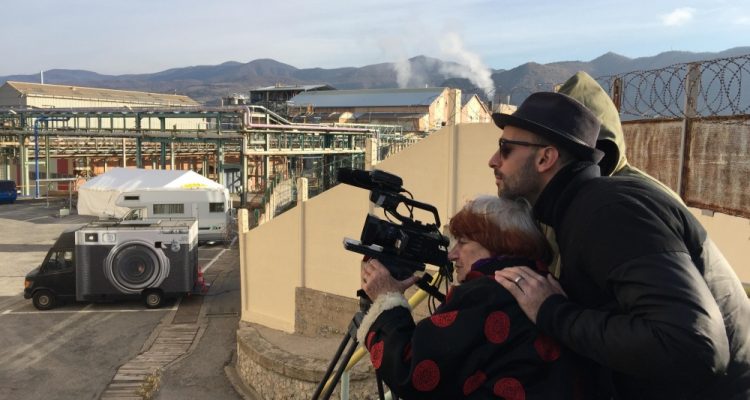Without Agnès Varda and the other filmmakers of the French New Wave — particularly the Left Bank auteurs — the essay film wouldn’t exist in its current shape and form. Perhaps best known for her classics of that period, the octogenarian director has displayed a renewed creative spirit — and found new audiences — with her personal essay films of the current century, “The Gleaners And I” and “The Beaches of Agnès.” Certainly, Varda hasn’t settled into the “late period” mode that typically seizes the elder statesmen and stateswomen of cinema.
READ MORE: The 20 Most Anticipated Films Of The 2017 Cannes Film Festival
Premiering Out of Competition at the Cannes Film Festival, her latest film “Faces Places” (the alliteration of the French title “Visages, Villages” rolls off the tongue a little better) is the perfect antidote to all the portentous and dour films unspooling along the Croisette. The documentary, co-directed by Varda and self-described “professional paster” JR, is no less spritely than the work of any first-time filmmaker at Cannes. The collaborative energy between the two makes for an endlessly charming documentary, as “Faces Places” manages to look forwards and backwards with touching insight.

The two artists set out with the objective of traversing France and, as the title states plainly, discover (and rediscover) people and locales from both of their pasts. JR’s art practice — likely less familiar to cinephiles than Varda’s corpus — consists of transforming photographs into large-scale murals, the surfaces of which include low-rise apartments buildings, silos, shipping containers and train carts. “Faces Places” is, then, a marriage of their two sensibilities: Varda’s cine-portraits and JR’s play on private canvases in public spaces. Where the two meet in the middle is in the manifestation of intimacy, whether it be the filmmaker baring her feet for a photograph, or JR introducing his friend to the grandmother that raised him.
The hosts of the film make for a wonderful odd couple, pitting lanky, buttoned-down JR against the diminutive Varda. She is quick to compare JR’s so-called “costume” — just as her own white-and-red pixie cut is a visual trademark — to that of Jean-Luc Godard. At first, this is ascribed to both men’s insistence on wearing sunglasses at all times, but the similarities in facial shape and other wardrobe choices becomes more and more apparent as the film wears on. In fact, the shadow of JLG hangs over the entirety of “Faces Places,” not only through a recreation of the race through the Louvre from “Band Of Outsiders” but in the choice of the crotchety filmmaker’s Swiss residence as the final face and place of the art endeavor.

This final sojourn makes for a bittersweet coda. The emotions the prospective meeting stirs up in Varda shine a light on the human core of such a mythologized moment as the New Wave, but one can’t help but feel that she, along with JR, cede too much credit and creative energy to such a stodgy figure as JLG. Godard is a creative giant, but his cynical outlook is antithetical to the warmth and wisdom that Varda exudes.
Aesthetically, “Faces Places” is New Wave in the most classic sense: its directors dueling in voiceover, jump cuts and match cuts, intertextuality (“Cleo From 5 To 7” and its film-within-a film as the major touchpoint) and reflexive references to its own construction (at one moment, Varda mentions that she messed up the transition from one sequence to the next). In the hands of such an experienced filmmaker, these devices are always exuberant and never posturing, as they might have come across if JR set out on the initiative alone.

Nonetheless, the maturity — and fragility — of the veteran director creeps in from the fringes of the frame, and the possibility that the audience might lose her at any time contributes an undercurrent of sadness to the whole affair. Her failing eyesight and JR’s insistence on obscuring his own eyes with shades, both of which get wrapped up in representational art and the cinematic gaze, remains the most important thread to weave through “Faces Places.”
One should consider the choice of medium for the project, which has received support from New York’s Museum of Modern Art amongst its more traditional film-financing sources (including Cohen Media Group, the U.S. distributor for the film). While cohesive and well-paced as a movie (a brisk 90 minutes), “Faces Places” could easily have been conceived as a television program, art installation or web series. Varda and JR are constantly playing with physical and emotional scales; the result is an image en abîme, a description which Varda herself levels at the application of a mural of a bombed house onto another ruined building. It is a testament to this essay film that it seems almost too modern for the arthouse at the same time as it reflects on the history of motion pictures. Above all a treat for art fans and cinephiles fond of French film history, the whimsy and wisdom of “Faces Places” is certain to win over a new generation of Varda and JR fans. [B+]
Check out the rest of our coverage from the 2017 Cannes Film Festival by clicking here.

